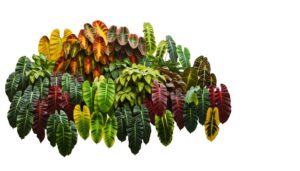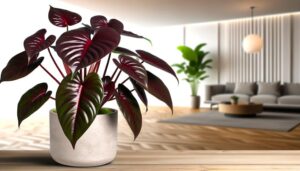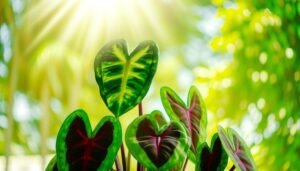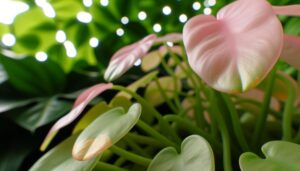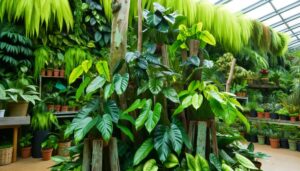What Is a Philodendron Hederaceum Micans Velvet Leaf?
Philodendron hederaceum micans, known as the Velvet Leaf philodendron, is a perennial climbing plant native to Central and South America. It features heart-shaped leaves with a distinct velvety texture, ranging in color from deep green to bronze.
The plant thrives in humid environments and requires bright, indirect light, well-draining soil, and consistent moisture levels. Its velvety leaf surface reduces water loss and provides protection from intense light.
This species is ideal for indoor cultivation, offering both functional benefits and aesthetic appeal. Discovering its unique features and care requirements can enrich your horticultural knowledge and home decor.
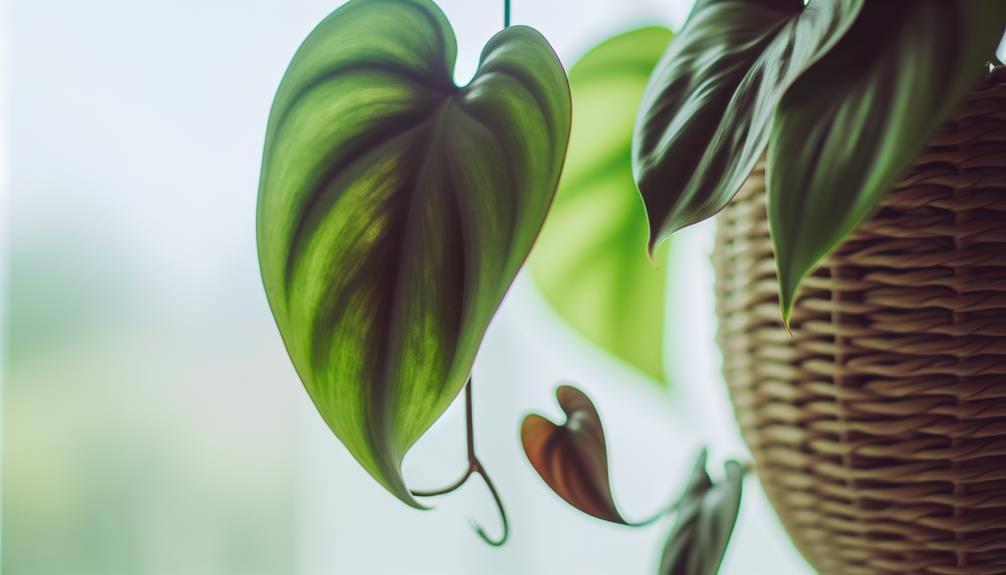
Key Takeaways
- Perennial Climbing Plant: The Philodendron Hederaceum Micans Velvet Leaf is a perennial climbing plant native to Central and South America.
- Heart-Shaped Leaves: It features heart-shaped leaves with velvety texture, offering aesthetic appeal and functional benefits.
- Color Variations: Leaves transition from bronze or copper when young to deep green as they mature, influenced by light exposure.
- Indoor Cultivation: Ideal for indoor cultivation, requiring bright indirect light, high humidity, and well-draining soil.
- Propagation: Propagation is efficiently achieved through stem cuttings, ensuring genetic consistency and robust growth.
Plant Overview
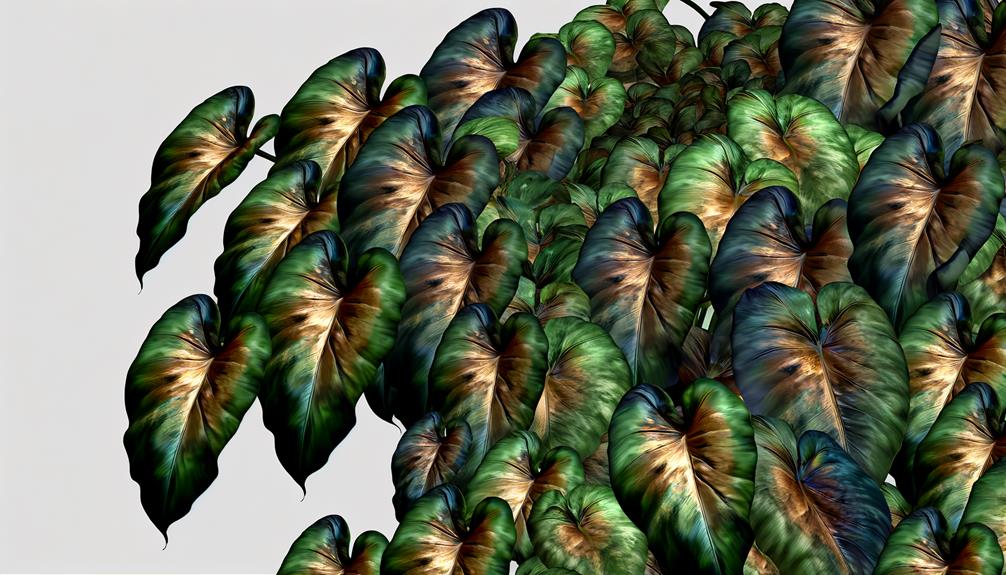
Philodendron Hederaceum Micans, commonly known as Velvet Leaf Philodendron, is a perennial climbing plant distinguished by its velvety-textured, heart-shaped leaves. Indigenous to tropical regions of Central and South America, this species flourishes in humid environments with indirect sunlight.
The leaves display a unique iridescence, changing in hue from deep green to bronze, based on light exposure. In ideal conditions, the plant can grow to lengths of up to several meters, using aerial roots to attach itself to supporting structures. The stem is slender, aiding its climbing growth pattern.
This philodendron is suitable for indoor cultivation, as long as it receives sufficient humidity and well-draining soil. Regular pruning is advised to uphold its visual appeal and promote vigorous new growth.
Unique Features
Philodendron Hederaceum Micans is distinguished by its velvety leaf texture, which imparts a soft and tactile quality to its foliage. The heart-shaped leaves exhibit significant morphological precision, enhancing the plant's ornamental value.
Additionally, the leaves' color variations—from deep green to bronze hues—offer a dynamic visual appeal that shifts with light and maturity.
Velvety Leaf Texture
What sets the Philodendron hederaceum micans apart is its unique velvety leaf texture, characterized by a soft, suede-like surface that exhibits a subtle iridescence under varying light conditions.
This distinctive texture not only enhances its aesthetic appeal but also provides several functional benefits. The velvety surface minimizes moisture loss and protects the plant from excessive sunlight.
This textural attribute also helps in dust repellence, ensuring cleaner leaves. Additionally, the texture can serve as a tactile identifier for plant enthusiasts, aiding in species recognition.
- Moisture Retention: Reduces water loss through the leaf surface.
- Sunlight Protection: Shields the plant from harsh light intensity.
- Dust Repellence: Keeps the leaves cleaner for longer durations.
- Tactile Identification: Assists in distinguishing the species.
Heart-Shaped Leaves
With their distinctive heart-shaped outline, the leaves display an anatomically unique arrangement that enhances both the aesthetic and functional characteristics of the Philodendron hederaceum micans.
The heart-shaped structure is not just decorative; it enables an ideal surface area for photosynthesis, thereby maximizing light absorption.
The leaf blades are sharply pointed at the tip and rounded at the base, creating a symmetry that is both visually appealing and structurally efficient.
Venation is pinnate, with a noticeable central midrib that provides mechanical support and efficient nutrient transport.
Margins are undivided, contributing to a streamlined profile that reduces wind resistance and potential damage.
This combination of form and function underscores the evolutionary adaptation of the species, tailored to its natural habitat.
Color Variations
The Philodendron hederaceum micans displays a remarkable array of color variations, from deep emerald greens to rich, velvety purples, that are influenced by factors such as light exposure and leaf maturity. These variations stem from the plant's ability to adapt to its environment, showcasing its unique pigmentation changes. Importantly, the leaves undergo significant chromatic shifts as they age and respond to different lighting conditions.
Understanding these color variations is essential for cultivating the Philodendron hederaceum micans to achieve the best aesthetic appeal and plant health.
- Young leaves: Typically show a bronze or copper hue.
- Fully developed leaves: Transition to shades of deep green.
- Limited light exposure: Encourages darker, more subdued colors.
- Bright indirect light: Enhances vibrant purple and reddish undertones.
Origin and History
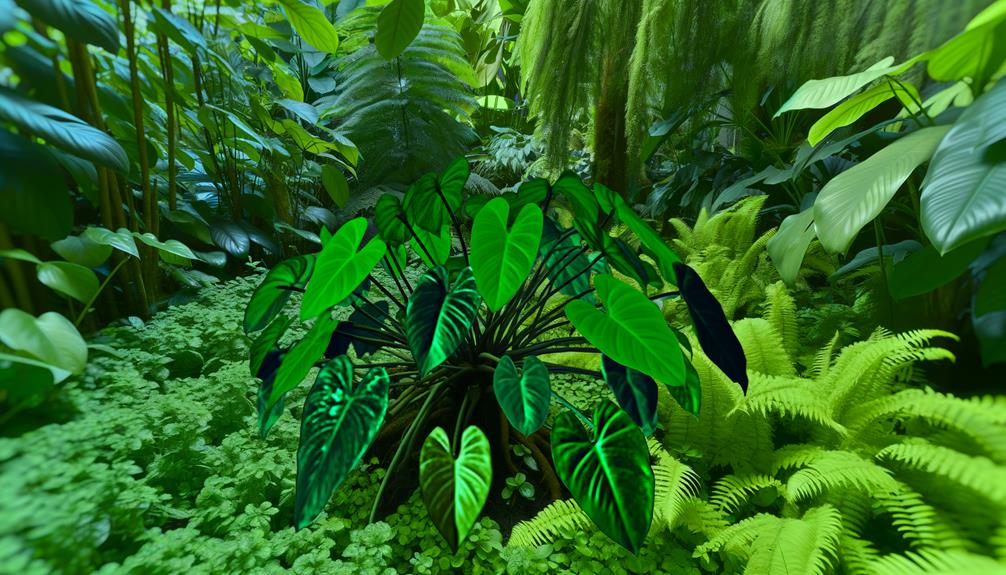
Native to the tropical regions of Central and South America, Philodendron hederaceum Micans has a rich history deeply entwined with the diverse ecosystems of these areas. This species thrives in the humid understories of rainforests, leveraging the shaded, moist environments for ideal growth. The plant exhibits remarkable adaptability, often found clinging to trees and rock formations. Its discovery dates back to botanical expeditions in the 19th century, where it garnered attention for its unique velvety foliage and resilience.
| Region | Climate Characteristics | Common Flora and Fauna |
|---|---|---|
| Central America | Humid, Tropical | Bromeliads, Orchids, Poison Dart Frogs |
| Northern South America | Warm, High Rainfall | Ferns, Jaguar, Capuchin Monkeys |
| Amazon Basin | Dense, Moist | Epiphytes, Sloths, Macaws |
| Andes Foothills | Variable Altitudes | Mosses, Hummingbirds, Spectacled Bears |
| Caribbean Islands | Coastal, Tropical | Mangroves, Sea Turtles, Pelicans |
Understanding its origin provides insight into its growing requirements and environmental preferences.
Ideal Growing Conditions
Best cultivation of Philodendron hederaceum 'Micans' requires specific environmental parameters. This includes exposure to indirect, bright light and maintaining ambient temperatures within the range of 18-27°C.
Additionally, consistent watering schedules and high humidity levels are essential to ensuring strong growth and vibrant foliage.
Light and Temperature
Philodendron hederaceum 'Micans' flourishes in bright, indirect light and prefers temperatures ranging from 65°F to 80°F, guaranteeing robust growth and vibrant foliage. The plant's light requirements are essential for photosynthesis, which directly impacts its overall health.
Excessive direct sunlight can scorch its delicate leaves, causing discoloration and damage. Conversely, insufficient light can lead to leggy growth and reduced vitality.
Ideal lighting conditions include:
- Softened sunlight through a curtain or shade to prevent leaf burn.
- Positioning near east or north-facing windows for prime light exposure.
- Avoiding close proximity to artificial heating sources to maintain temperature stability.
- Monitoring seasonal light changes, adjusting the plant's location accordingly to maintain consistent light levels.
Proper light and temperature regulation are fundamental to the Philodendron hederaceum 'Micans' thriving indoors.
Watering and Humidity
Maintaining appropriate watering practices and humidity levels is vital for ensuring the health and vigor of Philodendron hederaceum 'Micans'. This tropical species thrives in consistently moist, but not waterlogged, soil. It's essential to allow the top inch of the substrate to dry out between watering sessions to prevent root rot. Employing a well-draining potting mix can greatly mitigate water retention issues.
Regarding humidity, 'Micans' performs best in environments with 60-80% relative humidity. Utilizing a hygrometer to monitor ambient humidity and deploying a humidifier or pebble tray can effectively maintain these levels. Regular misting, while beneficial, should be done carefully to avoid fungal issues. Adhering to these parameters will promote lush growth and vibrant foliage.
Light Requirements
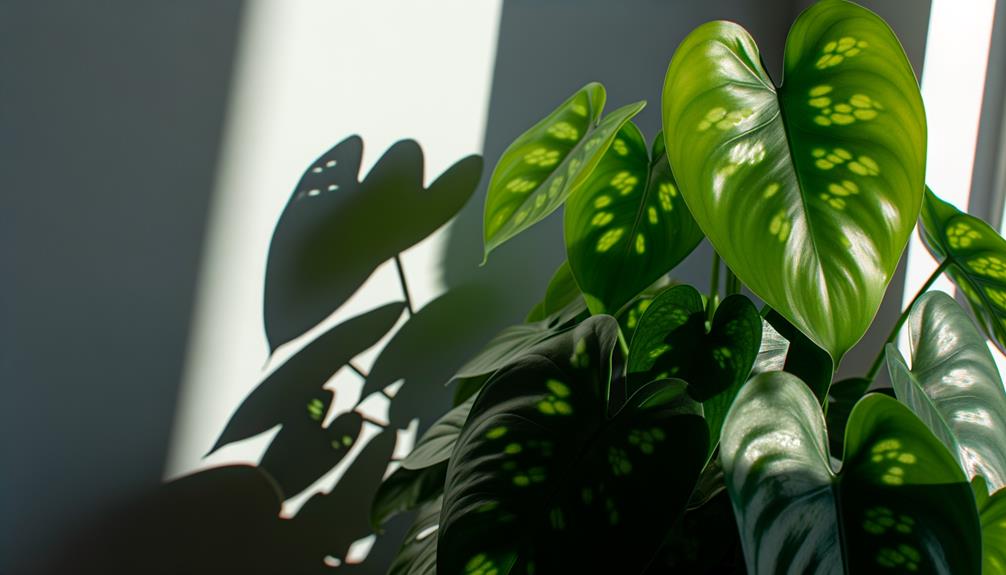
For best growth, Philodendron hederaceum 'Micans' thrives in bright, indirect light, resembling the dappled sunlight of its native tropical understory environment. Direct sunlight can harm its delicate, velvety leaves, leading to unsightly damage. It flourishes well under the following lighting conditions:
- Filtered Light: Place near sheer-curtained windows or under shade cloths.
- Artificial Lighting: Fluorescent or LED grow lights can replace natural light, maximizing 12-16 hours per day.
- Avoid Low Light: Prolonged low light conditions can result in leggy growth and reduced leaf vibrancy.
- Rotational Adjustment: Periodically rotate the plant to ensure uniform light distribution and balanced growth.
Following these specific lighting parameters guarantees ideal photosynthesis and overall plant health, encouraging strong development and vivid foliage coloration.
Watering Needs
Proper hydration is vital for Philodendron hederaceum 'Micans', requiring a balance to prevent both water stress and root rot. Best watering involves maintaining consistently moist, but not waterlogged, soil. It is advisable to water thoroughly, allowing excess water to drain, and then wait until the top inch of soil becomes dry before re-watering.
Overwatering can lead to root rot, characterized by yellowing leaves and a foul odor emanating from the soil. Conversely, under-watering results in wilting and browning leaf edges. Employing a well-draining container with drainage holes is essential to prevent water accumulation.
Regular monitoring of soil moisture levels using a moisture meter can ensure precise hydration, promoting robust growth and vibrant foliage in the 'Micans' cultivar.
Soil Preferences
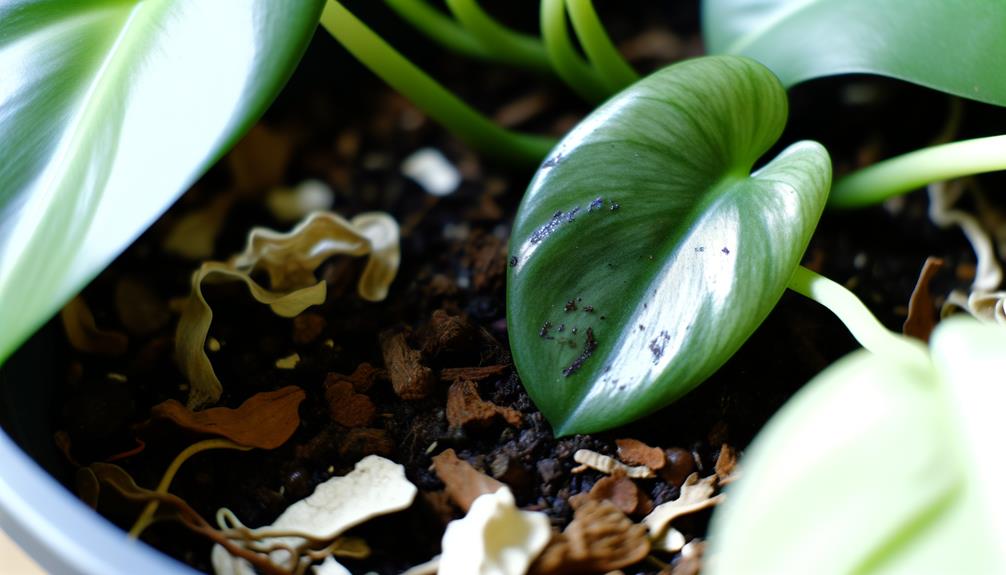
Philodendron Hederaceum Micans thrives in a well-aerated, nutrient-rich substrate with excellent drainage properties. Best soil composition includes a combination of peat, perlite, and orchid bark to balance moisture retention and aeration.
Ensuring proper drainage is essential to prevent root rot, while occasional fertilization meets the plant's nutrient requirements for robust growth.
Ideal Soil Composition
Consistently thriving in well-draining substrates, Philodendron hederaceum micans needs a soil composition that balances aeration, moisture retention, and nutrient availability. A soil mix that supports root health and growth should combine organic matter with inorganic components.
Key elements to include in the soil mixture are:
- Peat moss: Enhances moisture retention and provides an acidic pH.
- Perlite: Enhances drainage and aeration, preventing root compaction.
- Composted bark: Increases organic content, promoting beneficial microbial activity.
- Coco coir: Provides sustainable moisture retention and aeration without compacting over time.
These components collectively promote the soil's porosity, facilitating adequate oxygen flow to the roots while retaining essential moisture and nutrients, creating an ideal environment for Philodendron hederaceum micans to thrive.
Drainage Importance
Securing sufficient drainage is crucial for preventing waterlogged conditions that can lead to root rot and other harmful issues in Philodendron hederaceum micans. Ideal soil structure is essential; a well-aerated, chunky medium facilitates necessary oxygen exchange and moisture regulation.
Including perlite or pumice enhances aeration and prevents compaction, while organic matter like peat moss retains crucial moisture without saturating the root zone. Furthermore, a container with drainage holes is essential to allow excess water to escape, thereby reducing the risk of water accumulation.
Using a high-quality, well-draining potting mix tailored for aroids ensures that the delicate root system remains healthy and resilient. Effective drainage, in turn, creates an environment conducive to strong growth and longevity.
Nutrient Requirements
What specific nutrient profile does Philodendron hederaceum micans require for best growth and vibrant foliage?
This species thrives in a well-balanced, nutrient-rich soil that supports its lush, velvety leaves. Best growth is achieved with a soil mix that has excellent aeration and retains moisture without becoming waterlogged. A high-quality potting mix should include organic matter to enhance nutrient availability.
Key nutrients necessary for healthy development include:
- Nitrogen (N): Promotes robust foliage growth.
- Phosphorus (P): Encourages root development and flowering.
- Potassium (K): Supports overall plant vigor and disease resistance.
- Micronutrients: Elements like iron, magnesium, and calcium are essential for metabolic processes.
Ensuring a balanced fertilization regimen tailored to these requirements will result in a thriving Philodendron hederaceum micans.
Fertilization Tips
Proper fertilization of Philodendron Hederaceum Micans Velvet Leaf involves the application of a balanced, water-soluble fertilizer with an N-P-K ratio of 20-20-20, diluted to half-strength, during the active growing season. This typically spans from early spring to late summer. Administering this nutrient solution biweekly ensures prime growth and foliage vibrancy.
It is critical to avoid over-fertilization, which can lead to nutrient toxicity and root burn. Monitor the plant's response, adjusting the frequency and concentration as needed based on growth rate and leaf coloration.
During the dormant period in fall and winter, reduce fertilization to once a month or cease entirely, as the plant's nutrient uptake markedly diminishes. Proper timing and dosage are pivotal for maintaining plant health.
Pruning and Maintenance
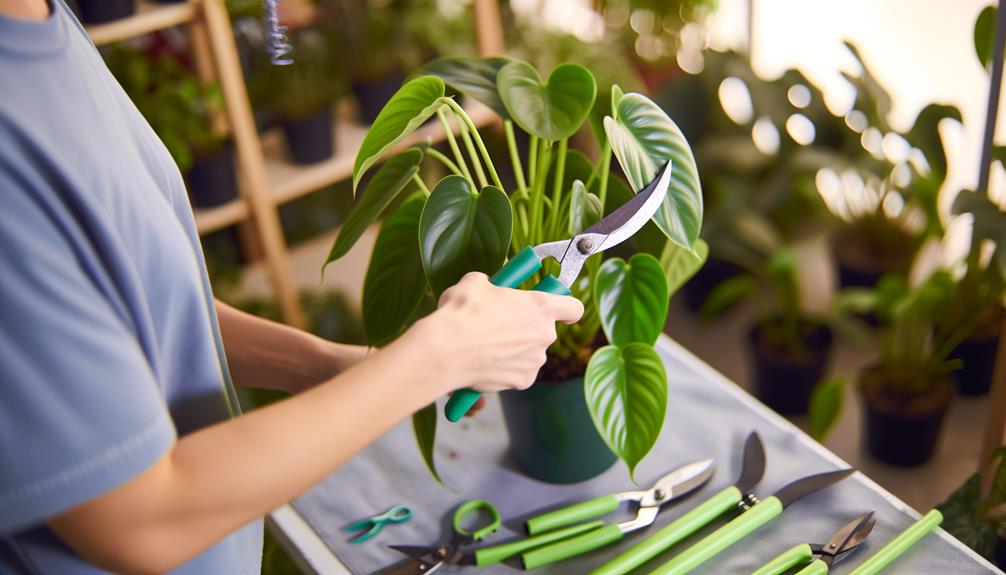
Regular trimming of the Philodendron Hederaceum Micans Velvet Leaf is crucial for promoting healthy growth and preventing a leggy, unkempt appearance. This process involves the removal of dead or yellowing leaves, trimming back overgrown stems, and encouraging bushier growth. Employ sterilized pruning shears to prevent the transmission of pathogens.
Focus on the following key points:
- Eliminate damaged or diseased leaves to maintain plant health.
- Cut back excessively long stems to encourage a more compact growth habit.
- Pinch off new growth tips to stimulate lateral branching.
- Dispose of plant debris properly to prevent potential pest infestations.
Regular maintenance guarantees the plant remains aesthetically pleasing and structurally sound, contributing to its overall longevity and health.
Common Pests
While diligent pruning and maintenance are essential for the health of Philodendron Hederaceum Micans Velvet Leaf, safeguarding it from common pests such as aphids, spider mites, and mealybugs is equally important to prevent infestations that can compromise its well-being.
Aphids can cause significant damage by siphoning sap, leading to distorted growth. Spider mites, often detectable by their fine webbing, induce stippling and yellowing of leaves through their feeding activities. Mealybugs manifest as white, cotton-like masses and excrete honeydew, promoting sooty mold.
Regular inspection, isolation of affected plants, and application of horticultural oil or insecticidal soap are effective management strategies. Maintaining ideal humidity and cleanliness further mitigates pest proliferation, ensuring the plant's health and vibrancy.
Propagation Methods
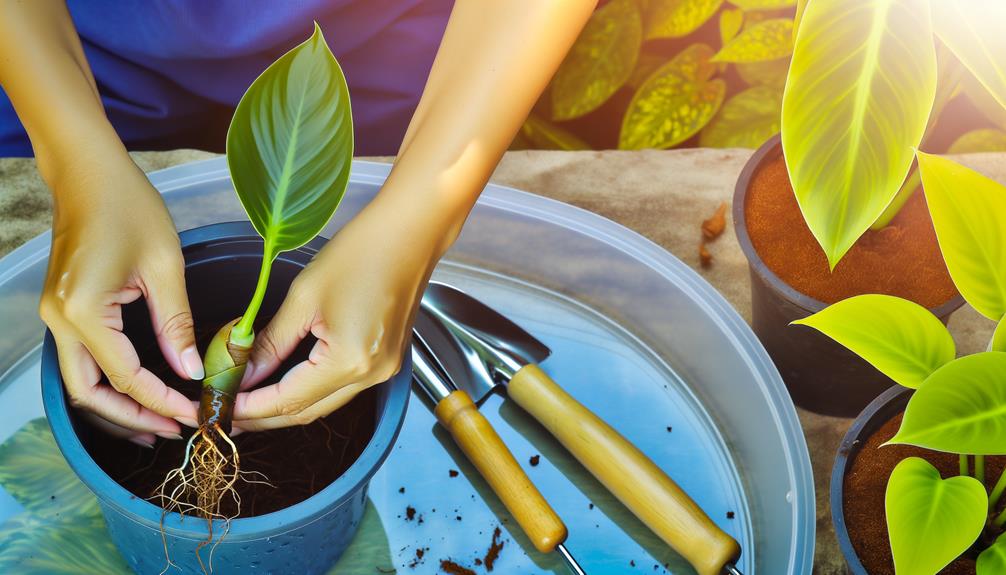
Propagating Philodendron Hederaceum Micans Velvet Leaf can be efficiently achieved through stem cuttings, a method that guarantees genetic consistency and promotes robust growth. The process involves selecting a healthy stem with at least two nodes, ensuring prime nutrient uptake and root development. Place the cuttings in water or a well-draining soil medium to facilitate root emergence.
Key steps for successful propagation include:
- Selecting a healthy stem: Choose a stem with no signs of disease or pests.
- Using sterilized tools: Prevents the introduction of pathogens.
- Ensuring appropriate lighting: Indirect, bright light promotes growth.
- Maintaining humidity levels: High humidity accelerates root formation.
Decorating Ideas
Integrating Philodendron Hederaceum Micans Velvet Leaf into your interior design can be achieved by strategically placing these plants in areas with ideal indirect lighting, enhancing both aesthetic appeal and plant health.
Utilize hanging planters or wall-mounted pots to elevate their trailing vines, creating an organic curtain effect. Position them near east-facing windows to guarantee filtered sunlight, which optimizes photosynthetic efficiency without causing foliage scorch.
For a more dramatic visual impact, combine Micans Velvet Leaf with contrasting textures, such as smooth ceramics or metallic finishes. Incorporate these plants into shelving units or atop cabinetry to exploit vertical space, ensuring the velvety leaves' iridescent quality remains a focal point.
Maintaining consistent humidity levels will further promote thriving growth and vibrant coloration.
Conclusion
In summation, Philodendron hederaceum 'Micans Velvet Leaf' represents a botanical marvel, characterized by its iridescent, velvety foliage and vining habitus.
This species, originating from Central and South American rainforests, thrives in environments with filtered light and high humidity.
Best care involves routine pruning, vigilant pest management, and strategic propagation.
Integrating this cultivar into interior spaces enhances aesthetic value, similar to a Victorian parlor adorned with botanical treasures, while contributing to the biodiversity of cultivated flora.

